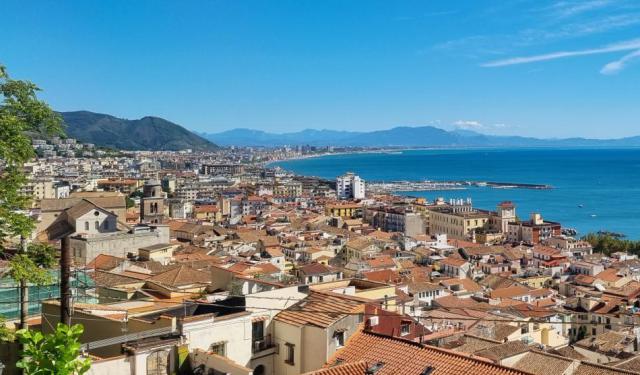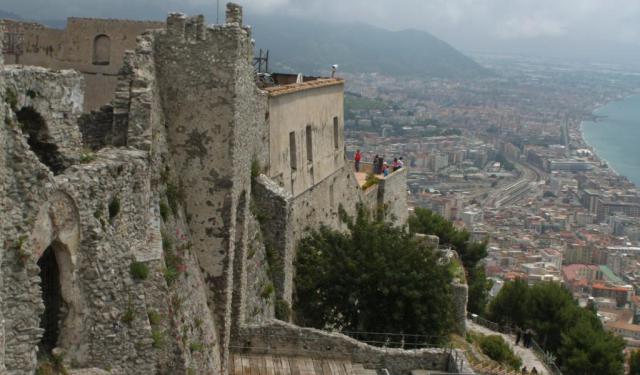Duomo di Salerno (Cathedral of Salerno), Salerno (must see)
The Cathedral of San Matteo, commonly known as Salerno Cathedral, stands as a venerable testament to history, with its roots tracing back to the auspicious founding by Robert Guiscard and consecration by Pope Gregory VII. Officially inaugurated in March 1084, the cathedral underwent a transformative chapter following the earthquake of June 5, 1688, which led to its complete reconstruction.
As one approaches the cathedral, the main entrance reveals modifications, and its courtyard is gracefully encircled by a covered passage supported by twenty-eight simple columns adorned with arches. Along the walls, a series of Roman tombs add an evocative touch to the surroundings. The southern side boasts the 12th-century bell tower, an architectural relic that stands in silent homage to the passage of time.
Salerno Cathedral unfolds its architectural narrative through a plan characterized by a longitudinal body comprising three naves, complemented by a horizontal transept with three apses and a quadriportico. The crypt, a distinctive element, assumes the form of a hall divided by columns, with apses mirroring those of the upper transept. Notably, the crypt serves as the resting place for the mortal remains of Saint Matthew. Legend holds that Gisulfo I transported the relics to Salerno in the 10th century. In 1081, upon the completion of the new cathedral dedicated to the evangelist, the remains found their eternal abode in the crypt, meticulously safeguarded.
The sculptural tapestry of Salerno Cathedral resonates with a captivating presence of animals. Beginning with the entrance, symbols of ecclesiastical power and charity manifest in the depiction of a lion and a lioness breastfeeding her calf. The architrave, adorned with a vine trellis, intertwines with dates pecked by birds, metaphorically alluding to the spiritual nourishment of the soul. At the extremes, a monkey and a lion symbolize heresy and the truth of the church, respectively. The cathedral's interiors are further embellished with decorative elements, featuring medieval heritage animals such as lions, horses, and centaurs.
As one approaches the cathedral, the main entrance reveals modifications, and its courtyard is gracefully encircled by a covered passage supported by twenty-eight simple columns adorned with arches. Along the walls, a series of Roman tombs add an evocative touch to the surroundings. The southern side boasts the 12th-century bell tower, an architectural relic that stands in silent homage to the passage of time.
Salerno Cathedral unfolds its architectural narrative through a plan characterized by a longitudinal body comprising three naves, complemented by a horizontal transept with three apses and a quadriportico. The crypt, a distinctive element, assumes the form of a hall divided by columns, with apses mirroring those of the upper transept. Notably, the crypt serves as the resting place for the mortal remains of Saint Matthew. Legend holds that Gisulfo I transported the relics to Salerno in the 10th century. In 1081, upon the completion of the new cathedral dedicated to the evangelist, the remains found their eternal abode in the crypt, meticulously safeguarded.
The sculptural tapestry of Salerno Cathedral resonates with a captivating presence of animals. Beginning with the entrance, symbols of ecclesiastical power and charity manifest in the depiction of a lion and a lioness breastfeeding her calf. The architrave, adorned with a vine trellis, intertwines with dates pecked by birds, metaphorically alluding to the spiritual nourishment of the soul. At the extremes, a monkey and a lion symbolize heresy and the truth of the church, respectively. The cathedral's interiors are further embellished with decorative elements, featuring medieval heritage animals such as lions, horses, and centaurs.
Want to visit this sight? Check out these Self-Guided Walking Tours in Salerno. Alternatively, you can download the mobile app "GPSmyCity: Walks in 1K+ Cities" from Apple App Store or Google Play Store. The app turns your mobile device to a personal tour guide and it works offline, so no data plan is needed when traveling abroad.
Duomo di Salerno (Cathedral of Salerno) on Map
Sight Name: Duomo di Salerno (Cathedral of Salerno)
Sight Location: Salerno, Italy (See walking tours in Salerno)
Sight Type: Religious
Guide(s) Containing This Sight:
Sight Location: Salerno, Italy (See walking tours in Salerno)
Sight Type: Religious
Guide(s) Containing This Sight:
Walking Tours in Salerno, Italy
Create Your Own Walk in Salerno
Creating your own self-guided walk in Salerno is easy and fun. Choose the city attractions that you want to see and a walk route map will be created just for you. You can even set your hotel as the start point of the walk.
Salerno Introduction Walking Tour
A vibrant seaport on the southeastern fringe of Italy's famed Amalfi Coast – the one often viewed as an attraction for jet-setters, – Salerno stands apart from its glitzy counterparts in that it is favored by those who seek a serene yet captivating retreat.
Human settlement at Salerno dates back to pre-historic times. The city's name, believed to have originated from the Latin... view more
Tour Duration: 2 Hour(s)
Travel Distance: 3.5 Km or 2.2 Miles
Human settlement at Salerno dates back to pre-historic times. The city's name, believed to have originated from the Latin... view more
Tour Duration: 2 Hour(s)
Travel Distance: 3.5 Km or 2.2 Miles
Salerno Medieval Architecture Walking Tour
Salerno's medieval architecture is a captivating tapestry woven with the threads of history, culture, and craftsmanship. Our journey through its facets starts by the sea, at the ancient New Gate (Porta Nova) that once served as a crucial entry point to the city, welcoming travelers and protecting residents within its sturdy walls.
Our next stop is the picturesque Medieval Aqueduct... view more
Tour Duration: 2 Hour(s)
Travel Distance: 2.8 Km or 1.7 Miles
Our next stop is the picturesque Medieval Aqueduct... view more
Tour Duration: 2 Hour(s)
Travel Distance: 2.8 Km or 1.7 Miles





